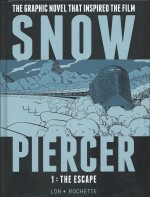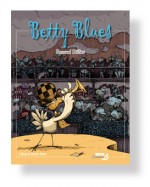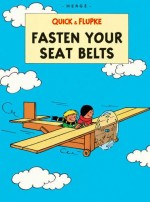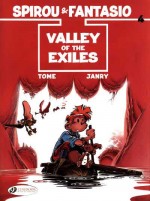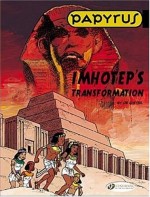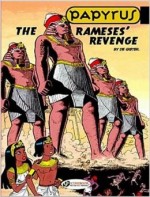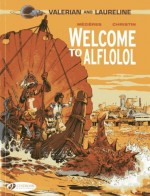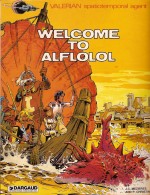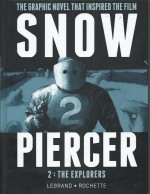
By Benjamin Legrand & Jean-Marc Rochette, translated by Virginie Selavy (Titan Comics)
ISBN: 978 -1-78276-136-5
Like the times that produced it, the Franco-Belgian comics classic Le Transperceneige was a troubled and ill-starred beast. The tale was originally conceived by prolific veteran scripter and occasional cartoonist Jacques Lob to be illustrated by his Superdupont collaborator Alexis (Dominique Vallet) but the artist’s untimely death on 7th September 1977 stalled the project until 1982 when painter, comics artist and book illustrator Jean-Marc Rochette (Pinocchio, Le petit poucet, Le chat botté, Candide, Le Dépoteur de Chrysanthèmes, Edmond le Cochon, Requiem Blanc) came aboard.
The delayed apocalyptic epic then ran in À Suivre in 1982 and 1983, with a collected edition published in 1984.
Although popular the sequel was not forthcoming until long after Lob died in 1990, whereafter Benjamin Legrand took up the concept with Rochette, producing two more epic tales of the Last Train to Nowhere…
No stranger to comics, Legrand (Lone Sloane, White Requiem, Gold & Spirit) is also a major mainstream prose author and French-language translator of such luminaries as Milton Caniff, R. Crumb, Robert Ludlum, Tom Wolfe, John Grisham and Nelson DeMille amongst many others. This varied background brought an edgy thriller-writing sensibility to the austere high concept of the original dystopian tomorrow mix…
With the imminent UK release of the movie Snowpiercer, Titan Comics (whose other translated offerings include The Hunting Party, Blueberry and other assorted classics by Enki Bilal, Moebius and others) have brought the entire three album masterpiece to our parochial Anglo-centric attention in two lavishly luxurious monochrome hardbacks. Both of Legrand & Rochette’s cool collaborations are here combined into a stunning collection of bleak and chilling End of the World turmoil: in one stunning, sturdy volume, as a companion to Snowpiercer book 1: The Escape.
In that original tale a new Ice Age had instantaneously descended over Earth and a microcosm of humanity rushed onto a vast vacation super-train repurposed as an ever-running ark of survival. As that monolithic futuristic engine began a never-ending circumambulation on tracks originally designed to offer the idle rich the ultimate pleasure cruise, the people rich, lucky or ruthless enough to secure a place quickly settled into their old pre-disaster niches and original divisive social stratifications.
Life continued for decades in this manner until a bold outcast named Proloff escaped from the sealed nether-end carriages, travelling the length of the 1001 cars pulled by the mysterious miracle of modern engineering. He acquired a romantic companion, clashed with the Military and Elite’s hierarchies, inadvertently sowing deadly discord until he reached the Engine herself and discovered the uncanny secret of the machine called “Olgaâ€â€¦
The drama now resumes in Snowpiercer book 2: The Explorers (originally serialised as Le Transperceneige: L’arpenteur in 1999) with a stunning revelation.
Soon after that train first sealed itself from the world and departed, a second, better equipped life-preserving cortège took off after it. Perpetually trailing the original, the denizens of the second Snowpiercer have also devolved into a far-from-homogeneous society: one also crippled by the overwhelming fear that they will inevitably smash into their forerunner one day…
Snowpiercer 2 has many modifications missing from the original. Designed as an icebreaker, the train also boasts radar detection systems, one-man short-hop flying modules and is able to brake and stop, allowing the hardiest individuals to debark and briefly scavenge amongst the frozen ruins of the world that’s gone…
There’s also a far more savvy autocracy in charge; scrupulously managing the disparate elements of the rolling society. Carefully constructed hologram adventures and TV shows placate passengers of all classes, an oligarchic Council manages every aspect of existence, a religion has been created to dole out hope, passive acceptance and guilt as required and the rulers run a gambling racket which provides a safe outlet for the lowest of the low…
Explorers have a short life expectancy and are highly expendable, but generally bring back far more flashy trinkets for the wealthy than salvaged food, drugs or technology for the masses.
The constant fear of collision has produced malcontents, cynics, terrorists, a huge need for anti-depressants and increasing incidents of a deranged group psychosis in many carriage dwellers. “Cosmosians†are gripped by a sure and certain belief that the entire vehicle is actually a spaceship hurtling through hard vacuum, rather than a wheeled entourage braving mere minus-130 degree wind and snow.
The terrifying panic which resulted from the first test-braking 15 years previously still scars most psyches but life on the rails is generally improving. Council head Kennel is delighted to learn that surface temperatures outside are slowly rising again (-121 in some places!), the birth rate is still successfully and voluntarily restricted whilst recycling, meat and agriculture output are at record levels.
Moreover his own daughter Val is constantly coming up with new and exciting Virtual Environment programs for the winners of the ubiquitous gambling contests to enjoy: histories, fantasies and adventures all enthral the Proles and keep them slavishly betting in hope of winning new and stimulating diversions…
Her latest idea is a bit of a shocker though: she wants to reproduce what the Explorers experience when they leave the train…
Despite her father refusing the request Val decides to go ahead anyway and sneaks back to the carriages where Reverend Dicksen is administering the blessing of Saint Loco upon the suicidal scavengers in preparation for their next foray.
As she spies on them she is accosted by the increasingly unstable Metronome – spiritual leader of the breakaway Cosmosian sect – but ignores his warnings, set on learning more about the anonymous stalwarts who risk their lives for medicines for the masses.
Explorer Puig Vallès is not an idealist. As the third-class grunt fatalistically trudges back from a deep-frozen museum, he is one of only four survivors of yet another art raid, stealing useless treasures for the coffers of the elite “Frontersâ€. His surly rebelliousness and smart mouth soon get him into hot water and he is arrested…
Uncaring of the trouble he’s in or the cheap price of lower class life, Puig is intercepted by Val, whose status and family connections allow her to do almost anything she desires – even interviewing a disgraced Explorer.
Fate seems to be against her, though, as Puig is promptly announced as a winner in the Lucky Lady lottery. His prize is not a virtual vacation, but the “honour†of piloting one of the deteriorating fliers on an exploratory (AKA suicide) mission to see if Snowpiercer 1 is stalled on the tracks up ahead…
And in a dark and gloomy carriage, Metronome and his acolytes finish a bomb that will divert the hurtling spacecraft from its present course and towards the “promised planetâ€â€¦
Puig knows he’s been set up to die and breaks free, stealing a gun and running for he knows not where, but is captured after a ferocious fire-fight. Val, meanwhile, has discovered that the train’s archives and historical records have been doctored: there’s evidence of anti-fertility drugs being added to the water, and that momentous day 15 years ago when she personally witnessed the death of Puig’s parents has been somehow deleted…
Near the front, the eternally vigilant “Radarists†have spotted a crisis which needs confirmation. A vast bridge pings back as damaged, but on-site inspection is vital to avoid disaster. Val clandestinely confers with Puig, just before the disgraced Explorer is subjected to a kangaroo court and charged with causing the deaths of the other Explorers in his team.
His guilt a foregone conclusion, he is sentenced to Community Service and ordered to fly a flimsy, malfunctioning scout plane to inspect the failing span ahead of the train.
His terrifying sortie confirms the radar data, and the train frantically brakes to avoid disaster. However, by the time Puig turns the plane back, the Icebreaker has switched to full reverse and is speeding away. Determined not to die, he gives chase in the dying flier, and miraculously travels through a brief burst of sunlight.
Shocked and galvanised he nurses the plane onward, even avoiding anti-aircraft fire from the train and discovers that his rolling home has a super engine at each end…
He threatens to crash the plane into the retreating cars and, as the Council deliberate the potential harm he might cause, Val – listening in on tapped lines – broadcasts the conversation to the entire populace.
Consummate politician Councillor Kennel does the only thing possible: regaining public support by proclaiming Puig a hero and taking him fully into the elite’s confidence by sharing all the Train Elite’s secrets with him.
As a Councillor, the rebel anarchist has no choice but to become a co-conspirator and in a horrifying moment of revelation meets an elderly Explorer who describes how the first “braking†was actually the collision everyone has dreaded for years. The original Snowpiercer is now the rear end of their own vastly snaking train. Every moment of fear and anticipation since than has been manufactured to control the people…
The chilling triptych concludes in the immediately-following Snowpiercer Book 3: The Crossing (serialised in 2000 as Le Transperceneige: La traversée) as Puig chafes under a burden of secrets and his new role as Councillor, but one with far less power than the established members.
At least he no longer fears a collision that can never happen, but his sense of threat has not diminished, but rather widened…
When Metronome’s fanatics finally detonate their bomb at the North End of Upper Second-Class, the explosion wrecks the train braking system. Naturally Puig leads a reconnaissance expedition, allowing adversarial Councillors Reverend Dicksen and fellow hardliner The General opportunity to assassinate the Explorer upstart whilst he is occupied cutting free the destroyed cars, effectively chopping the train – and humanity – in half.
As frantic evacuation procedures take effect, the Reverend dispatches fanatical cold-resistant children he’s been training to dispatch the despised enemy, but even clinging to roof of a rocketing carriage in lethal freezing winds Puig is far harder to kill than anybody realised…
With an Engine at either end, the two halves of the train are quickly separated by frozen miles whilst Puig covertly rejoins wife Val and leads a coup. With Dicksen and the General incarcerated and resources impossibly scant for the people crammed into their half of the train, Kennel then reveals one last piece of potentially life-changing news.
The Radarists have for some time been receiving radio transmissions from across the frozen sea. Perhaps somewhere other pockets of human civilisation exist…
Even if the rails hold firm and bridges are still passable, eventually the truncated train will collide head on with its severed other half if the passengers don’t starve, freeze or kill each other first.
With Councillor Kennel on-side and determined to preserve some vestige of the human race, the Explorer, tantalised by an impossible hope, decides to employ the train’s never-tested Snow Chain technology to leave the tracks completely and take everybody out across the ice-locked, frozen ocean in search of the originators of that beguiling transmission…
Unfortunately the bold strike into the unknown is far less dangerous than the fanatics still riding within, and even the despondent, electronic phantom of Proloff, psychically bonded to the original Snowpiercer engine as a cerebral ghost within the machine, can’t help against the bloody religious uprising fomented by Dicksen, Metronome and the General…
And there are even more deadly revelations and surprises awaiting them in the cold, dark unknown across the sea…
This harsh exploration of society in crisis is a gripping tale depicting different kinds of survival values no reader of fantasy fiction could possibly resist, and one long overdue for major public recognition.
And by reading this volume, you’ll see far more than the movie adaptation could possibly cover…
Transperceneige/Snowpiercer and all contents are ™ and © 2013 Casterman.
Snowpiercer volume 2: The Explorers is scheduled for release on February 25th 2014




